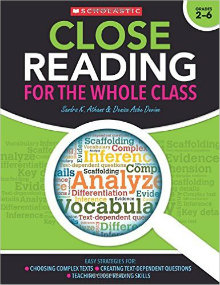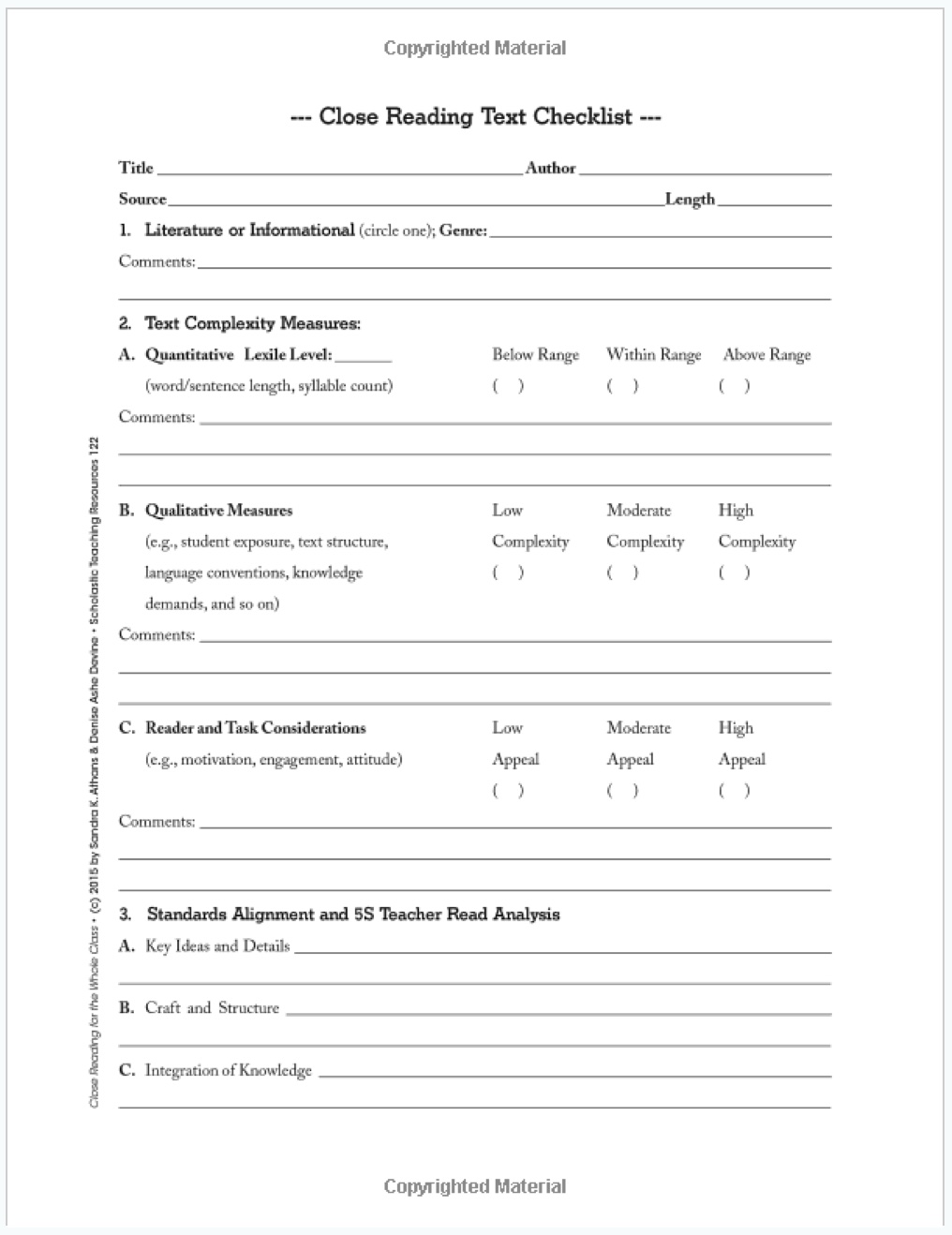Close Reading for the Whole Class
Close Reading for the Whole Class (Grades 2-6)
By Sandra K. Althans and Denise Ashe Devine
(Scholastic, 2015 – Learn more)

The very first Common Core Anchor Standard for Reading states that students will:
Read closely to determine what the text says explicitly and to make logical inferences from it; cite specific textual evidence when writing or speaking to support conclusions drawn from the text.

However, the common thread that runs through the tapestry of close reading is “reading a passage very attentively being mindful of its content, structure and value. It is a deep, analytical method in which readers construct meaning based on the author’s intention…identifying key ideas or the position an author emphasizes, evaluating his or her word choice, and determining how an author organizes sentences and paragraphs to support an idea.”(Close Reading for the Whole Class, p. 7)
Take the angst out of close reading
Scholastic Publishing Company, founded in 1920 as a publisher of a school magazine, has done it again. They have published a book about close reading that will take the angst out of the topic. At first, I wasn’t sure about this book. Was it another set of lesson plans? Was it just research discussion without any practical advice or ideas? Were there any samples for me so I could see it “in action”?
As I read on, I found that Close Reading for the Whole Class is a good reference for all teachers because it encompasses all of the features: the research based rationale for close reading supported by practical lesson plans and examples.
Truth is that the first time I heard about close reading, my initial thought was… “Read the same text several times over a period of a few days. You have to be kidding! The students will be bored, and I probably will be, too.” Amazingly, the opposite happened. Excitement grew in my class as we re-examined text from a variety of perspectives. I felt as if I were a photographer, looking closely through different lenses, finding bits of beauty in the author’s art. My students began to examine the text not just as a set of words but for craft, evidence, and purpose.
A teacher friendly organization
I have to admit as well, I have read quite a few books about close reading. Some are theory based; some are lesson plans and units; some are a mixture of both. What I like about Sandra K. Althans and Denise Ashe Devine’s book is the layout of the chapters, each focusing on an important part of the close reading teaching methodology.
Chapter 1: Introduction to Close Reading
Chapter 2: Lesson Design and Delivery
Chapter 3: Text Selection
Chapter 4: Text Dependent Questions
Chapter 5: Performance Tasks
Chapter 6: Academic Discussion
Chapter 7: Close Read Guides: A Nifty Tool for Instruction
Chapter 8: Nitty-Gritty Strategies and Take -5 Mini Lessons for Closer Reading
An early example of the the authors’ practical approach is found in Chapter Two. I usually cringe when I see a script for teaching a concept or mini lesson because some teachers read word-for-word from the script. However, I was impressed with what the authors provided here. By using the sample text, The Champion of Quiet, by Tracey Stewart, the authors showed how to introduce close reading to students, annotate skillfully, and finally teach them how to probe deeper with authentic performance tasks.
Although I do not recommend teaching from a script, the sample provides the novice or veteran teacher with a glimpse into how to explain close reading to students. In addition, the authors generously provide an annotated example of “The Champion of Quiet” as an additional resource. (I wish there was a digital link to the annotated resource.)
Written from classroom experience
Close Reading for the Whole Class is easy to follow and designed for “real life classrooms.” It is evident that this book was written for teachers by teachers. I appreciated the candor of the authors as they described their journey into close reading, being forthcoming about the trials and errors they experienced and what they learned from them.
The advice is practical but not preachy! When you read the book, you feel as if you have well-versed and understanding literacy coaches sitting beside you.
The lessons and examples the authors provide are easily adaptable for any grade level, which is an added bonus. Close reading is not just a strategy to use solely with the lower elementary grades, but is recommended also for middle school and high school students. Being able to “close read” is a skill that transcends all grade levels.
Take the time and reflect on your current reading instruction, whether your district uses basal readers or Readers Workshop. Use the Close Reading Text Checklist to examine and analyze the texts you are currently using – picture books, children’s magazines or short texts – to provide the students with rigorous texts that meet the children’s needs and interests.
For individual or group study
Although you can read the book independently, Close Reading for the Whole Class (Grades 2-6) can be used with colleagues as a professional learning group or book study, or with teachers who are interested in learning more about close reading. Professional development activities at the end of each chapter can be used as a part of your Professional Learning Community or book club discourse or to “tweet out” some questions.
I agree with Tony Cardamone, principal and district K-5 ELA Coordinator from Baldwinsville, New York: “Sandra Athans and Denise Ashe Devine have taken the concept of close reading and demystified it. They have carefully connected the CCSS throughout their book and provided a ‘playbook’ for teachers to follow as they raise the level of rigor and dialogue in their classrooms.” Close Reading for the Whole Class (Grades 2-6) earns a place on my growing bookshelf!
Linda Biondi is a fourth grade teacher at Pond Road Middle School in Robbinsville, NJ, and a long-time Morning Meeting practitioner. She’s also the recipient of several educational grants, a Teacher Consultant with the National Writing Project and a participant on the NJ Department of Education Teacher Advisory Panel. Linda participates in ECET2 Celebrate Teaching which has posted an interview with her.





































